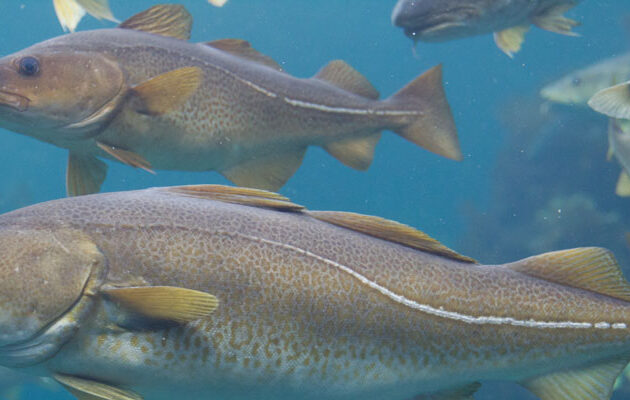Breeding programme for cod

Nofima runs the national breeding programme for cod, which provides important data for developing a profitable cod farming industry.
Start
31. Dec 2001
Funded by
Ministry of Trade, Industry and Fisheries
Project Manager(s):
Other Participants:
Administrative manager
Manager for scientific and operational issues
Results
Experiences from a variety of other species show that selective breeding is a very effective tool for improving the production qualities of farmed fish and therefore the economics of aquaculture. For this reason, the national breeding programme for cod was started in 2002. The programme is operated on behalf of the Ministry of Trade, Industry and Fisheries and its objective is to breed cod for aquaculture that have better growth properties than wild cod, as well as a greater resistance to important diseases of fish.
Methodology
The breeding programme for cod conducts combined family and individual breeding. This is a highly effective method, based on the fact that fish produce large numbers of offspring, which makes it possible to conduct effective breeding also on traits that are difficult or impossible to measure in fish that will be used for further breeding.
These characteristics could include those that can be measured only in dead fish (such as fillet yield) or that require the fish to be exposed to disease. In such cases, the characteristics are examined in the full and half siblings of the breeding fish.
The national breeding station for cod has the capacity to produce up to 300 family groups during a spawning season. This is more than enough to ensure good breeding progress and maintain sufficient genetic variation in order to avoid inbreeding. In the first few years, families were produced annually, which resulted in three parallel cohorts of the same generation, as the generational interval of cod is three years.
These cohorts have been combined and we will now aim to produce families every three years. In years when no family production takes place, we will still produce a certain number of fry for use in research or, alternatively, for sale to commercial parties.
From tank to sea cages
During the family production process, families are kept in separate tanks for six months after hatching. By this time, the fry will have reached a weight of 20-30 grams. A given number of individuals from each family are then individually tagged using electronic PIT-tags and distributed in larger tanks, each containing representatives from every family. These fish are then transported to the breeding programme’s sea cage facility and to a test station elsewhere in the country. There is also a possibility to tag fish for experimental purposes, such as challenge tests, where the disease resistance of different cod families is tested.
Breeding values
The growth characteristics of each individual fish are recorded during the grow-out at sea, and corresponding data is also collected from the test station. These data are used to calculate the breeding values for the individuals available for breeding in the sea cage facility. The best individuals are brought back to the breeding station to become the parents of the next generation.
The selection of broodstock is done in a way that ensures that the genetic variation of the breeding population is maintained at appropriate levels. When new families are produced, the family backgrounds of the father and mother are also checked to avoid inbreeding in each mating.
Future methodologies
The genome (total genetic material) of the cod has now been mapped. This allows for the development of new and more efficient breeding methods, in which it is possible to select for the most suitable broodstock based on the genomic information of the fish. Recently, a tailor-made SNP-array was developed for cod. This tool can be used to map the genetic architecture of economically important traits. Use of genomic tools are expected in particular to improve the effectiveness of breeding in traits that can not be recorded on breeding candidates, and reduce the need for experiments, which are both expensive and undesirable in terms of fish welfare.
Rapid growth
The fish will reach a slaughter weight above 3.5 kg (more than 2 kg after gutting and removal of the head) in the autumn 2.5 years after hatching. As there are significant price differences in farmed fish above and below 2 kg, it is important to reach this size before the fish reaches sexual maturity at the age of three. Early sexual maturation, before fish reaches slaugther weight, leads to significant weight loss due to spawning and should therefore be avoided. It is also of environmental significance, as slaughter before sexual maturation will prevent the fish from spawning in the cages and the spread of the fertilized eggs into the surroundings.
Improved cod fry
In addition to the genetic benefits of the breeding work, research undertaken as part of the breeding programme for cod has also contributed significant improvements to the production methods used for cod fry. This has resulted in the production of cod fry with better growth, higher survival rates, less deviation in size, fewer deformities and lower mortality after being released into the sea.
The improvements that have been made, both in breeding and in production, provide cod farmers with a much better starting point regarding their production than they had before. This provides increased production predictability and increased opportunities to achieve profitability within marine-based farming.
Nofima’s cod roe and broodstock production is certified according to the GLOBALG.A.P standard.
Watch and hear more about the cod breeding program
Aqua Nor 2023
The large AquaNor exhibition is held every two years in Trondheim. Below you can see an interview with Nofima Scientist Anne Kettunen.
Swedish Radio (SR)
Sveriges Radio and the program “Science Radio” visited Nofima’s cod breeding station at Kraknes outside Tromsø.
They met Nofima researcher Øyvind Johannes Hansen, who is responsible for the cod breeding program.
Click here to listen to the radio broadcast on SR.se (Swedish language)
Similar projects

